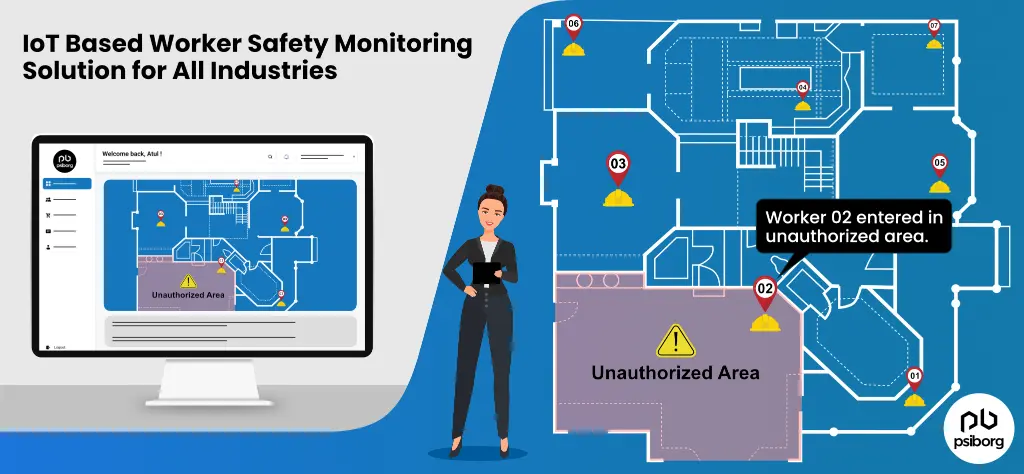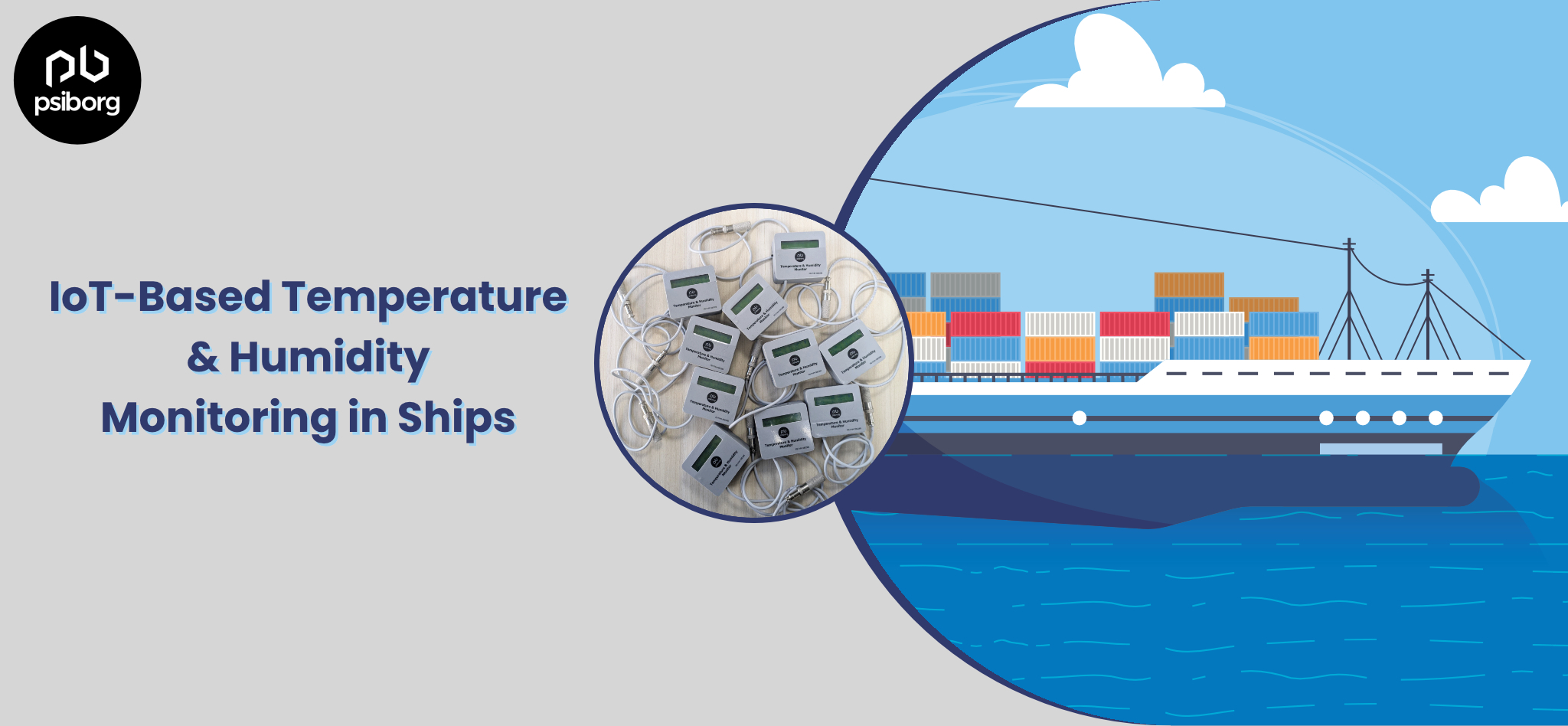Ensuring employees’ safety and well-being is the major responsibility of businesses to boost employees’ morals. This requires worker safety monitoring. And what’s better than using IoT for anything tracking and monitoring?
So, if you are on this page in search of a worker safety monitoring solution then stick till the end to understand how the solution works and where you can get the solution.
Role of IoT in Worker Safety Monitoring
From manufacturing plants and construction sites to office buildings, maintaining safety in the workplace has evolved. Because the conventional approaches no longer work and so the solutions have also evolved.
And when it comes to real-time monitoring and workers’ safety monitoring, nothing seems more promising than IoT (Internet of Things).
The role of IoT in manpower safety monitoring involves monitoring workers’ activity and movement, air quality, temperature, humidity, and sound levels.

Worker safety monitoring solution uses sensors and connected devices to monitor the conditions of a workplace and collect data in real time to prevent accidents and maximize safety.
The main aim of using IoT in manpower safety monitoring is to provide real-time insights into workers’ activity, identify potential risks, and make it possible to take proactive measures to prevent any sort of accidents in the smart workplace.
Importance of IoT in High-Risk Industries
High-risk industries, like construction, mining, oil and gas, and manufacturing, are inherently dangerous. Workers face constant threats from falling objects, exposure to toxic fumes, electrical hazards, and heavy machinery.
Workers face constant threats from falling objects, exposure to toxic fumes, electrical hazards, and heavy machinery.
Here’s where the concept of worker safety becomes paramount. Every company in a high-risk industry has a moral and legal obligation to create a safe working environment. Traditional safety measures like personal protective equipment (PPE) and established protocols play a crucial role. However, these methods have limitations. Human error can lead to improper use of PPE, and traditional systems often lack real-time data on worker well-being and environmental conditions.
The IoT Safety Net: How it Works
An IoT worker safety system is a network of interconnected devices and software designed to monitor and manage workers in risky environments.
This system primarily consists of three main components:
1. Wearable Sensors
These are devices worn by workers that collect data about their physical condition and location. They can be integrated into smartwatches, helmets, or even as standalone devices. Some of the common sensors to be included in IoT wearables app solutions are:
- Accelerometers: To detect falls, impacts, and sudden movements.
- Heart rate monitors: To track worker fatigue and stress levels.
- GPS trackers: To pinpoint worker location.
2. Environmental Sensors
These devices monitor the worker’s surroundings for potential hazards. These environmental factor-detecting IoT devices can be stationary or mobile and are generally used to measure:
- Gas levels: To detect toxic gases in the environment.
- Air quality monitoring: To identify pollutants or contaminants.
- Noise levels: To protect workers from excessive noise exposure.
- Temperature and humidity monitoring: To monitor for extreme conditions.
- Light levels: To assess potential visibility issues.
3. Data Analytics Platform
It is a central hub that collects, processes, and analyzes data from wearable and environmental sensors. The platform gives detailed data analysis and visualization to generates alerts, reports, and insights for safety managers and supervisors.
Real-Time Monitoring: The Foundation of Safety
Real-time monitoring is essential for maintaining worker safety. In fact, remote near real-time monitoring is the main reason to go for an IoT-based worker safety monitoring solution.
It involves the continuous collection and analysis of data from sensors to provide up-to-the-minute insights into worker safety conditions. By processing data in real time, the system can:
- Detect emergencies immediately. Such as if a worker falls, is exposed to hazardous gases, or experiences a sudden change in vital signs, the system will trigger an immediate alert.
- Allow proactive interventions. By identifying potential risks before they can escalate, the system allows for timely interventions, like evacuating workers from hazardous areas or providing medical assistance.
- Improve worker performance. Real-time data on worker fatigue, stress, and environmental conditions is utilized to better revise work schedules and reduce the risk of accidents.
- Improve operational efficiency. By monitoring equipment and asset usage, the system can help improve maintenance schedules and prevent downtime.
Geo-fencing and Worker Location Tracking
Geo-fencing is a virtual boundary defined by GPS coordinates. When a worker’s device enters or exits a geofenced area, the system generates an alert.
This feature really helps in:
- Indoor and outdoor location tracking. As it helps in determining the accurate location of workers within a facility or in remote work areas.
- Access control, to restrict access to hazardous zones or unauthorized areas.
- Lone worker protection. By monitoring the location of workers who operate alone the system can send an alert if the worker fails to check in or moves outside a defined area.
- Emergency response. This is to quickly locate workers in case of an emergency.
- Tracking worker movement to improve workflows and identify bottlenecks.
Beyond the Basics: Some Advanced Safety Features
While the basics of an IoT safety system are real-time monitoring and location tracking, its true potential is determined through advanced features that predict and prevent accidents.
Early Warning Systems to predict dangers
An IoT safety system goes beyond simply reacting to incidents; it can anticipate them. By continuously analyzing data from sensors, the system can identify patterns and anomalies that indicate potential hazards.
Environmental monitoring sensors can detect changes in air quality, gas levels, temperature, and humidity that may signal developing risks. For instance, a gradual increase in carbon monoxide levels in a confined space can be an early warning sign of a potential equipment malfunction.
Also by analyzing data on worker fatigue levels, equipment performance, and environmental conditions, the system can predict the likelihood of accidents occurring during specific times or under certain circumstances.
Worker Health Monitoring
Protecting worker health is as crucial as preventing accidents. IoT-enabled wearable sensors offer unprecedented insights into a worker’s physical condition.
Sensors embedded in smart wearables track vital signs such as heart rate, blood pressure, and body temperature. This data can help identify signs of stress, fatigue, or underlying health issues.
Emergency Response
In the event of an accident or emergency, a well-designed IoT system can significantly improve response times and outcomes.
When a critical event occurs, the system can send immediate alerts to supervisors, emergency teams, and healthcare providers via SMS, email, or mobile app. These alerts can include detailed information about the incident, the location of the affected worker, and the nature of the emergency.
Real-world Examples of IoT Saving Lives
Several businesses have already adopted worker safety monitoring solutions to ensure the safety of their workforce. These are a few examples, to name a few:
Smart Helmets in TATA Projects for Construction Site Safety
This Indian construction giant- TATA projects has implemented IoT-based safety solutions across its projects. Smart helmets equipped with sensors monitor worker location, heart rate, and head impact. Geo-fencing is used to restrict access to hazardous zones. The system has successfully prevented numerous accidents by detecting potential falls, heat stress, and unauthorized entry into restricted areas.
Workers Health Tracking in Coal Mining
Coal India Limited: India’s largest coal producer has deployed IoT-based coal mine safety monitoring systems in its underground mines. Wearable devices track miner location, vital signs, and gas exposure levels. Environmental sensors monitor air quality, methane levels, and temperature. This system has significantly reduced accidents caused by gas leaks, collapses, and equipment failures.
IoT based Worker Safety Solution in Reliance Petrochemical Plants
Reliance Industries: This conglomerate has implemented IoT solutions in its petrochemical plants to ensure worker safety. Wearable devices monitor worker fatigue, stress, and exposure to hazardous chemicals. The system also detects equipment malfunctions and process deviations, preventing accidents and minimizing downtime.
Summing Up,
Companies can face a huge loss due to even a little accident at the workplace.
However, smart IoT solutions can help companies avoid loss by improving workers’ safety effectively.
Industries that have remote work sites and loan workers can greatly benefit from this smart IoT solution.
PsiBorg Technologies develops such smart fully custom worker safety monitoring solutions for businesses across all types of industries.
Being an IoT product development service provider, we have developed labour tracking and manpower monitoring solutions with features like SOS alerts and fall detection.
So developing a worker safety monitoring solution is nothing new for us.
Reach out to us with your specific requirements, and let’s discuss developing an IoT prototype or the entire product.
FAQs
Integrating an IoT based worker safety monitoring system is considered important in high-risk industries to prevent accidents, reduce injuries, and ensure compliance with safety regulations. It maximizes the capability of real-time monitoring of hazardous conditions, promotes timely intervention, and safeguards workers’ well-being. This boosts overall workplace productivity and work morale.
Workers’ safety is efficiently monitored through utilizing IoT technology. The system uses wearable sensors and environmental sensors to monitor, record, and inform supervisors about workers’ activities and danger exposures.
The list of features offered by a worker’s safety monitoring system are:
- Fall detection
- SOS alert
- Real-time monitoring
- Hazard detection
- Fatigue and Stress Tracking
- Compliance Reporting
- Location Tracking





